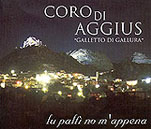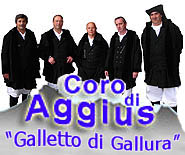| RECORD
PRODUCTION of the Chorus of Aggius "Galletto di Gallura" |
|
|
|
|
This ns. last job, is concentrating of choral tradition, music, poetry
and high expression handed on secular from generations of Aggesi, to reached
we and that to ns. time we want to transmit to the future people. We have
carried out this recording near, the warehouse in the handicraft zone
of Aggius, put on hand from Nicola Lepori, than
obviously we ringraziamo for its availability and patience, with two technicians,
Paul Zannin and Massimo Cossu, than
having little felt the ns. archaic melodie, have had to try the adaptation
of the ns. voices with modern multimediali means of recording type them.
The first problem has been the evening recreational club, than fresh and
somewhat humid of May, to brought not little raucousnesses to the ns.
ugole not professional and accustomed to sing around to a imbandita table
and some wine flask, rather than to complicated highly sophisticated equipment
and microphones.
However we have carried out before a test in order to see the effect of
the voices and of the improvised one it knows it of recording, that we
have repeated in an evening more in compliance with the good season and
after to have improved the ns. habit to the electronic cited ones eletronick.
Feeling the duplications, we found some problem in the attacks and the
ends, not having no director inside of the ns. chorus, some forgetfulness
of the witnesses executed to memory and that at the moment of the execution,
above all for emotion have been mistaken. The technicians have said that
many errors could be correct, and that the modern technology on hand would
have performed miracles, but the ns. worry was that the ended job would
have introduced a such perfection that without a doubt came to travisare
the ancient coralità.
The ns. final decision has been that to record all the pieces of continuation
like was to the ns. regular tests and except some repetition, we have
approved of this job seppur with its errors and some slobbers, but what
we introduce it is the ns. chorus with its defects and its limits but
after to have felt the recordings of the ns. predecessori, one of best
the coralità than voices, to confirmation of this, the falsetto
feels without that nobody the songs in the majority of the passages in
the executed pieces. |
| |
 |
|
PREFACE
AL CD
“Ancient
how much the dawn” had to define the traditional
song of Aggius Gabriele D' Annunzio when
a group of singers, in 1927, left the small center of the Gallura
for tournée in the Peninsula making a stage also the Vittoriale,
mythical villa of the Vate on the lake of Garda. Between those singers,
all settuagenari, venticinquenne the Salvatore- “Balori”
Stangoni, to which, for the dowries canore and the
squillante voice, Of Notice it attributed the name of “Galletto
di Gallura” accompanied that it for long-life of
genuine interpreter of the Aggese song. That name, decades ago,
were assumed from the chorus of the singing young people that had
the “Galletto di Gallura” like they master. And that
they execute the pieces of this CD. The song, together to the dances,
has represented a moment centers them of the cohabitation of a community
tied to the ancient sour-pastorale world which that of Aggius, country
between most typical of the Gallura. The song has scandito every
manifestation and recurrence, religious civilian or, of communitarian
or familiar within. It was practical and divertimento for all, men
and women, excluded from the single choral song in church. Between
all how many emerged were equipped of sure vocal canore qualities
and. They were then these to sing the Uffizi of the Saint Week and
Passover, the funeral novenas of the Saint Patrono and rituals.
and to intonare the song that animated the round dance in the festivities,
species in the presence of illustrious hosts. At last to represent
the country in some escape or important manifestation. To say of
the origin of this tradition means to riandare to the pagani rituals
legacies to the earth and its rhythms of fecondazione, collected
production and that then the Christianity has absorbed and made
own. The infuence of the liturgy of the church, last through the
constitution of the Confraternite and the wide participation to
the same ones, has been however determining. The type of song appears
mostly “cultured”, of tightened ecclesiale derivation.
On reasons of religious songs from the Miserere to the rituals of
the Saint Week, from the Stabat Mater to Queen Coeli- then witnesses
of profane content have grafted themselves. A substrate of profane
song persists in what spirit the round, assimilable dance for sure
backs to executed the primordiali songs of the Sardinia to “tenores”.
Of the secular tradition of the aggese song the chorus “Galletto
di Gallura” places like genuine interpreter and continuatore
faithful.
AGGIUS, May 2005 TONIO BIOSA |
LU
PALTI' NO M'APPENA
Lu paltì no m'appena
Da li me' lochi
e da l'amichi cari,
Cu aria sirena
Anzi palchissu passaria mari
You
can demand the single
CD to € 10,00 + shipment expenses |
|
| |
| SACRED
PIECES WITH PROFANE WITNESSES |
|
|
LA
TASGJA
E’ il
ns. modo di cantare, l’accordo corale Aggese
per eccellenza.
La me’
ninfa tarrena sta sicura
sempri ti dè cantà lu chi ti canta
Chi nò s’agatta un’alta criatura
bedda simili a tè da cima a pianta.
Traduzione:
Mia ninfa terrena stai sicura sempre ti canterà
colui che ti canta
non esiste altra creatura bella simile a Te da cima
a pianta.
|
|
|
ERA
BEDDA UN’AGNULA PARIA
Quartina
della traduzione del San Michele In Bosco dello
Stecchetti, fatta dal poeta Aggese MichelePisano.
Il titolo originale della poesia gallurese è
: Amori a l’umbra d’un buscu. Aprile
1883. Si esegue sulla melodia del Miserere Solenne.
In questo brano, il falsetto si stacca dal resto
del coro e partendo dal “contra” in
ottava alta va’ per suo conto per rientrare
in accordo pieno nel finale.
Per questi acuti Salvatore Stangoni, “Balori
Tundu” ricevette l’appellativo di “GALLETTO
DI GALLURA” da parte di Gabriele D’Annunzio.
Era
bedda un’agnula parìa
Una dea di cieli una fata
Da li so tricci un’odori n’iscia
Di frisca rosa appena sbucciata.
Traduzione:
Era bella un’angela parea
Una dea dei cieli una fata
Le sue trecce emanavano un profumo
Di fresca rosa appena sbocciata.
|
|
|
TANTU
TEMPU DUNOSA
Poesia
da serenata. Si esegue sulla melodia del Passio
della Settimana Santa.
Tantu
tempu dunosa
era in disizzu di idì a Te
Pa la gjenti odiosa
sogu eu graziosa in tanti peni
In tanti peni sogu dunosa si no vengu a visitatti
Si senza di Te stogu
l’ammiratti gjia me valutu pogu.
No’ mi ali a nienti
Tuttu chiddu carigniu e amistai
Si no t’aggjiu presenti
Cori e ne menti m’arriposa mai
No’ m’arripposa cori
Si no’ ti digu fiori diligatu
Di cantu t’aggjiu amori
A tutti l’ori ti staria a latu.
Traduzione:
Tanto tempo, tesoro (carica di doni) avevo desiderio
di vederti, per la gente odiosa sono io, o graziosa,
in tante pene. Sono io in tante pene, o tesoro se
non vengo a visitarti, se stò senza di tè
l’ammirarti mi è valso a poco.
Non valgono a niente tutte quelle amorevoli carezze,
se non sei qui presente né cuore né
mente mi riposan mai.
Non mi riposa il cuore se non ti dico fiore delicato,
il mio amore è tanto che a tutte le ore ti
starei accanto.
|
|
|
LU
PALTI’ NO M’APPENA
Quartina
della poesia in gallurese “Ultima Sera”
del poeta Michele Pisano scritta nel 1882
Si esegue sulla melodia del Magnificat della novena
del Santo Natale.
Lu
paltì no’ m’appena
Da li mè loghi e da l’ammighi cari;
cun aria sirena,
anzi, pal chissu passaria mari;
ca’ mi tulmenta a moltu
è lu lassà a te prenda di poltu.
Traduzione:
Partire non mi accora dai miei luoghi e dagli amici
cari
Con aria serena, anzi, per questo oltrepasserei
il mare;
ciò che mi tormenta da morire, è lasciare
te in preda ai pericoli della vita.
|
|
|
LA
FILUGNANA
Classico
canto della festa, si eseguiva principalmente durante
la cardatura della lana o durante la “festa”
della vendemmia, in genere vi era il botta e risposta
di due cantori.
Li
steddi sendi minori
Imparetili a baddà,
si nò so baddadori
istentani a cuiuà.
Putaiola
chi nò tinni
Nò la tratta putadori,
abà che calatu soli
bedd’e ora d’andazzinni.
Traduzione:
Insegnate i fanciulli a ballare,
se non sapranno ballare tarderanno a sposarsi.
Roncola
che non tinnisce non la usa il potatore,
ora che il sole è calato bisogna rincasare.
|
|
|
MISERERE
SOLENNE
Canto
religioso della Settimana Santa Anticamente eseguito
dai cori delle seicentesche confraternite di Aggius
quella del SS Rosario e dall’Arciconfraternita
di Santa Croce durante la processione di tradizione
Spagnola, del simulacro del Cristo Crocifisso e
della Madonna Addolarata.
Anticipo de “Lu Sgraamentu”
(la deposizione del Cristo dalla Croce) prima del
canto della voce solista del “Tibi soli peccavi
|
|
|
STABAT
MATER
Canto
religioso della Settimana Santa Anticamente eseguito
dai cori delle seicentesche confraternite di Aggius
quella del SS Rosario e dall’Arciconfraternita
di Santa Croce durante la processione di tradizione
Spagnola, del simulacro del Cristo Crocifisso e
della Madonna Addolarata.
Cantato alternativamente al Miserere Solenne.
|
|
|
REGINA
COELI
Brano
originale in Latino, gli Aggesi delegano al coro
l’esecuzione del canto alla Madonna il giorno
di Pasqua durante “l’intoppu”
(l’incontro del Cristo risorto con la Madonna)
sempre di tradizione spagnola, e durante la solenne
Messa Pasquale.
La particolarità di questa melodia, è
ancor meglio rimarcata dall’esecuzione in
dissonanza tale da raggiungere il quarto di tono
da parte del “Contra”, di fatto il coro
non può essere accompagnato da alcuno strumento
musicale in quanto attualmente non esistente.
|
|
|
LA
BRUNEDDA
E’
sicuramente il canto più famoso del coro
di Aggius,
altro non è che una semplice serenata fatta
da un’analfabeta alla sua bella.
Sapendo contare solo fino a cinque inizia dall’infinito,
cinque quattro tre due ed una
la mia brunetta è bruna.
|
|
|
| LA
TASGJA CU LU BADDU A PASSU
All’iniziale canto di accordo prettamente
aggese, aggiungiamo l’antica tradizione del
canto a ballo
Vita
da un bedd’alburu pusesi
Par esse fra li pianti più lucrosa
Lu tarrenu no fussi ca ti desi
La ista c’hai tu misteriosa.
Bedda tutta frunduta ti pisesi
Par esse fra li stelli luminosa.
Li
to’ labbri incarnati priziosi
So beddi assai più che diamanti
Ca ti de’ imprimì basgji amurosi
Po dissi fultunatu chiss’amanti.
Lu
baeddu e lu pettu so’ almosi
Parini d’alabastru fendi incanti
So’ abbeddu li biddesi e l’almusura
C’hani lu to’ amanti variatu
Da
undi n’arà presu la pittura
La folma di biddesa chi t’ha datu
L’occi c’hani a vidì lu to’
spendori
Sempri d’eni adorà ca t’ha criatu.
Traduzione:
La vita hai preso da un bell’albero, per essere
fra le piante la più ricca
Il terreno fù chi ti diede il misterioso e
sfuggente sguardo,
bella tutta rigogliosa cresciuta per essere fra stelle
la più luminosa.
Le tue labbra carnose, preziose assai più dei
diamanti
Chi t’imprimerà baci amorosi potrà
dirsi fortunato, quell’amante
Il
tuo mento ed il petto sono armoniosi
E scolpiti nell’alabastro ne attirano l’attenzione
Sono tali le beltà e le tue grazie che hanno
stregato il tuo amante.
Chissà
chi ha ispirato le bellezze a te donate
Gli occhi che vedranno il tuo splendore sempre
dovranno adorare chi ti ha creato |
|
|
|
|
|
 |

